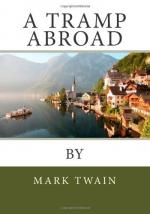This began to look reasonable. It certainly began to account for the German cream which I had encountered and marveled over in so many hotels and restaurants. But a thought struck me—
“Why did not each ancient dairyman take his own teacup of milk and his own cask of water, and mix them, without making a government matter of it?’
“Where could he get a cask large enough to contain the right proportion of water?”
Very true. It was plain that the Englishman had studied the matter from all sides. Still I thought I might catch him on one point; so I asked him why the modern empire did not make the nation’s cream in the Heidelberg Tun, instead of leaving it to rot away unused. But he answered as one prepared—
“A patient and diligent examination of the modern German cream had satisfied me that they do not use the Great Tun now, because they have got a bigger one hid away somewhere. Either that is the case or they empty the spring milkings into the mountain torrents and then skim the Rhine all summer.”
There is a museum of antiquities in the Castle, and among its most treasured relics are ancient manuscripts connected with German history. There are hundreds of these, and their dates stretch back through many centuries. One of them is a decree signed and sealed by the hand of a successor of Charlemagne, in the year 896. A signature made by a hand which vanished out of this life near a thousand years ago, is a more impressive thing than even a ruined castle. Luther’s wedding-ring was shown me; also a fork belonging to a time anterior to our era, and an early bootjack. And there was a plaster cast of the head of a man who was assassinated about sixty years ago. The stab-wounds in the face were duplicated with unpleasant fidelity. One or two real hairs still remained sticking in the eyebrows of the cast. That trifle seemed to almost change the counterfeit into a corpse.
There are many aged portraits—some valuable, some worthless; some of great interest, some of none at all. I bought a couple—one a gorgeous duke of the olden time, and the other a comely blue-eyed damsel, a princess, maybe. I bought them to start a portrait-gallery of my ancestors with. I paid a dollar and a half for the duke and a half for the princess. One can lay in ancestors at even cheaper rates than these, in Europe, if he will mouse among old picture shops and look out for chances.




